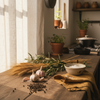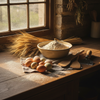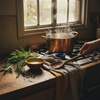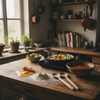Best Baking Cookware: Health-First Pan Selection
Key Takeaways
- Even heat distribution, durability, and health-first materials are essential for successful baking cookware.
- Aluminum offers excellent heat conductivity and fast browning but can react with acidic ingredients if uncoated.
- Glass and ceramic provide gentle, even heating ideal for delicate desserts but require careful handling to avoid thermal shock.
- Cast iron excels in heat retention and crust development but requires regular seasoning to maintain its protective coating.
- Silicone molds offer flexibility and easy release but must be certified free of harmful chemicals for safe use at high temperatures.
Table of Contents
- The Foundation of Baking Success: Why Your Cookware Matters More Than You Think
- Understanding Baking Cookware Materials: Performance, Safety, and Longevity
- The Heat Conductivity and Browning Factor, Why Dark Pans Tell Different Stories
- Selecting the Right Pan for Your Recipe Type
- Health and Safety Considerations, What Leaches Into Your Batter?
- Care, Maintenance, and Longevity, Extending Your Bakeware Investment
- Troubleshooting the 5 Most Common Baking Cookware Problems
- Building Your Baking Cookware Collection, Strategic Investment Approach
- Future Considerations, Where Baking Technology Meets Health Innovation
- Cook Boldly, Bake Confidently, Your Kitchen Deserves the Best
The Foundation of Baking Success: Why Your Cookware Matters More Than You Think
Picture this: you've measured every ingredient to the gram, preheated your oven precisely, and followed that Pinterest-perfect recipe to the letter. Yet your cookies emerge burnt around the edges with raw centers, or your cake develops an unfortunate dome that screams "amateur hour." The culprit? Your baking cookware. For best results, consider upgrading to premium baking cookware designed for even heat distribution and durability.
Unlike stovetop cooking where technique can compensate for mediocre pans, baking demands precision from your tools. Heat distribution, material composition, and surface finish directly impact texture, browning, and consistency. A thin aluminum sheet pan conducts heat three times faster than glass, while dark-colored surfaces absorb 15% more heat than light ones, differences that transform identical batters into completely different results. If you want to elevate your baking, explore award winning kitchen utensils that complement your bakeware for professional-quality results.
Quality baking cookware operates on three non-negotiable pillars: even heat distribution, structural durability, and health-first materials. When your tools match the precision that baking demands, failed batches become rare exceptions rather than frustrating norms. Your spatulas, scrapers, and mixing tools matter equally, which is why DI ORO's award-winning, forever-chemical-free silicone tools complement premium bakeware by ensuring proper mixing and damage-free transfer techniques.
Understanding Baking Cookware Materials: Performance, Safety, and Longevity

Aluminum Bakeware, The Industry Standard
Aluminum's exceptional heat conductivity makes it the professional baker's choice. It conducts heat three times faster than glass, creating consistent browning patterns across your entire batch. Light-colored aluminum reflects heat for gentle, even baking, ideal for delicate cakes and pastries. Dark aluminum absorbs heat more aggressively, browning cookies and brownies 10-15% faster.
Uncoated aluminum offers the purest heat transfer but can react with acidic ingredients like lemon juice or buttermilk. Textured surfaces improve browning on items like pizza crusts, while nonstick coatings reduce cleanup time but may limit browning potential.
Glass and Ceramic Bakeware, Visual Appeal with Caveats
Glass and ceramic retain heat 25-30% longer than metal, requiring temperature reductions of 25°F and extended baking times. This slower, more even heating produces superior results for showcase desserts and custard-based items where gentle heat prevents curdling.
Thermal shock poses the primary risk, never transfer hot glass directly to cold surfaces. Ceramic naturally absorbs odors and stains from spices and acidic ingredients, requiring monthly deep cleaning with baking soda paste to maintain performance.
Cast Iron and Cast Aluminum, The Heavy-Duty Choice
Cast iron's superior heat retention maintains consistent temperatures throughout the baking process, creating exceptional crust development on rustic breads and cornbread. Properly seasoned cast iron develops natural nonstick properties that improve with use.
Monthly seasoning with food-grade oil prevents rust and maintains the protective coating. Store in moisture-free environments, even brief humidity exposure can compromise the seasoning layer that took months to develop.
Silicone Molds and Pans, The Modern Convenience Factor
Pro-grade silicone offers unmatched flexibility and release properties without greasing. However, material quality varies dramatically, cheap silicone may leach chemicals at baking temperatures above 350°F.
LFGB certification ensures European food safety standards, while BPA-free and PFAS-free certifications guarantee no forever-chemical exposure. DI ORO's commitment to forever-chemical-free, pro-grade silicone in our award-winning spatulas and scrapers reflects the same standard you should demand from silicone baking molds. For more on the importance of spatulas in baking, read this comprehensive guide to spatulas.
| Material | Heat Conductivity | Browning Speed | Durability | Best For |
|---|---|---|---|---|
| Aluminum | Excellent | Fast | Very Good | Cookies, sheet cakes |
| Glass | Good | Slow | Good | Showcase desserts |
| Cast Iron | Excellent | Very Fast | Excellent | Rustic breads, cornbread |
| Silicone | Fair | Slow | Good | Flexible molds, bundt cakes |
The Heat Conductivity and Browning Factor, Why Dark Pans Tell Different Stories
Light-colored pans reflect heat while dark surfaces absorb it, creating browning differences of 10-15% with identical recipes. Dark pans may require temperature reductions of 10-20°F to prevent over-browning, while shiny aluminum reflects heat most effectively for gentle, even results.
The "brownie paradox" illustrates this perfectly, dark pans often burn edges while centers remain underbaked. Professional bakers tent foil over brownie edges during the final five minutes when using dark pans, protecting edges while centers finish cooking.
Selecting the Right Pan for Your Recipe Type
Recipe success depends on matching pan characteristics to baking requirements. Different batters, doughs, and techniques demand specific heat distribution patterns and release properties.
Cookies and Sheet Pan Baking
Half-sheet pans (13" × 18") in thin-gauge aluminum create the ideal cookie environment. Thick pans cause uneven baking, centers remain underdone while edges overcook. Parchment paper or forever-chemical-free silicone mats eliminate sticking and reduce cleanup time by 60%.
Rotate pans 180 degrees halfway through baking to compensate for oven hot spots, even in modern convection units.
Cakes and Deep-Dish Baking
Round 9-inch pans suit layer cakes, while 9"×13" rectangles handle sheet cakes and brownies. Fill pans only halfway to two-thirds full, overfilling creates domed tops and uneven crumb structure. Light-colored pans provide gentler, more controlled browning for delicate cake batters.
Specialty Molds, Bundt and Decorative Baking
Silicone Bundt molds offer superior release properties but require LFGB certification to ensure food safety. Fill three-quarters full for optimal rise and shape definition. Invert immediately onto cooling racks, trapped steam causes sogginess if left in flexible molds. For more tips on choosing the right spatula for baking and decorating, see this article on the small spatula for baking and decorating.
Health and Safety Considerations, What Leaches Into Your Batter?

Modern baking cookware safety extends beyond basic food contact to include forever-chemical contamination and coating degradation. Understanding these risks protects your family's long-term health.
PFAS (forever chemicals) appear in some nonstick coatings and low-grade silicone products. These compounds persist in the environment and human body, making prevention the only protection strategy. LFGB certification, Europe's stricter food safety standard, ensures materials meet rigorous testing for chemical migration. For a deeper dive into the science of chemical migration in cookware, read this peer-reviewed study on cookware safety.
Acidic batters containing lemon, vinegar, or buttermilk can interact with bare aluminum, creating metallic flavors. Glass or ceramic eliminates this concern entirely. Cheap silicone molds may leach chemicals at temperatures above 350°F, making certification verification essential for frequent bakers.
Care, Maintenance, and Longevity, Extending Your Bakeware Investment
Proper maintenance transforms quality baking cookware from a purchase into a decades-long investment. Each material demands specific care protocols to preserve performance and food safety.
Material-Specific Cleaning Methods
Aluminum requires hand washing with warm soapy water, dishwashers cause pitting and discoloration. Remove acidic stains with baking soda paste; let sit 10 minutes before gentle scrubbing. Glass and ceramic tolerate dishwashers but hand washing preserves surface finishes and prevents thermal shock damage.
Cast iron demands immediate drying and monthly seasoning with food-grade oil to prevent rust. Silicone handles dishwashers well, but hand washing extends flexibility. Stubborn residues respond to 15-minute hydrogen peroxide soaks. For more on flexible spatulas that protect your bakeware, check out this guide to the flexible spatula for cooking and baking.
Seasonal Refresh Protocol
Monthly deep cleaning restores aluminum shine and removes residue buildup. Quarterly cast iron inspection prevents rust formation before it compromises seasoning. Annual replacement of visibly worn nonstick coatings eliminates health risks from degraded surfaces.
Replace ceramic or glass showing hairline cracks immediately, thermal stress creates bacteria harboring points and breakage risks during baking.
Troubleshooting the 5 Most Common Baking Cookware Problems
Consistent baking results require understanding how cookware affects common failure points. These solutions address root causes rather than symptoms.
Cake Sticking: Insufficient release preparation or premature removal causes adherence. Apply two-part grease (butter plus flour) or use parchment rounds. Cool 10 minutes before inverting, structure needs time to set.
Uneven Browning: Dark pans absorb excessive heat, creating burnt edges with raw centers. Switch to light-colored aluminum or reduce temperature by 25°F. Rotate pans halfway through baking to compensate for oven hot spots.
Pan Warping: Thin-gauge metal buckles under thermal stress. Invest in professional-grade thickness and avoid temperature shock by preheating pans gradually. For more information on safe cookware choices, see this report on cookware safety and chemicals.
Persistent Odors: Silicone absorbs aromatics from spices and extracts. Neutralize with hydrogen peroxide soaks or store with activated charcoal between uses.
Coating Degradation: Metal utensils scratch nonstick surfaces, creating chemical exposure risks. Use forever-chemical-free silicone tools exclusively, protecting both your baking cookware and your family's health.
Building Your Baking Cookware Collection, Strategic Investment Approach

Smart collection building prioritizes versatile pieces over specialty items, focusing on materials that deliver consistent results across recipe types.
Essential Foundation (Budget: $60-80): Two 9-inch round aluminum pans, one 9"×13" glass rectangle, one half-sheet pan, and one 12-cup muffin tin cover 80% of home baking needs. This combination handles layer cakes, brownies, cookies, and muffins with professional-level heat distribution. For best results, pair your bakeware with award winning kitchen utensils designed for baking and mixing.
Intermediate Expansion (Additional $80-120): Add ceramic loaf pan for breads, silicone Bundt mold for decorative cakes, and cast iron skillet for rustic applications. Choose LFGB-certified silicone exclusively, cheap alternatives compromise both performance and safety.
Pro-Level Arsenal (Complete Investment: $250-400): Include specialty tart pans, multiple sheet pan sizes, and decorative molds. At this level, material quality becomes crucial, professional-grade thickness prevents warping and ensures decades of reliable performance. For those seeking the best wide spatula for baking, consider this review of top-rated wide spatulas.
Pair quality baking cookware with forever-chemical-free mixing tools. DI ORO's award-winning silicone spatulas protect your cookware investment while ensuring precise folding, mixing, and transfer techniques that separate amateur results from professional-quality baking.
Future Considerations, Where Baking Technology Meets Health Innovation
Emerging baking technologies focus on precision temperature control and advanced material science. Ceramic-titanium composites promise superior heat distribution with lifetime durability, while smart pans integrate temperature sensors for foolproof timing.
However, the most significant advancement remains the elimination of forever chemicals from all food-contact surfaces. As awareness grows, LFGB certification will become the minimum standard rather than premium feature. Home chefs investing in baking cookware today should prioritize certified materials that meet tomorrow's safety expectations.
The integration of precision tools with quality cookware represents the next evolution in home baking. When your mixing, measuring, and transfer tools match your cookware's quality standards, technique becomes the only variable in achieving consistent, professional results.
Cook Boldly, Bake Confidently, Your Kitchen Deserves the Best
Quality baking cookware transforms recipes from hopeful experiments into predictable successes. Material science, heat distribution, and health-first manufacturing create the foundation for culinary confidence.
The three pillars, material performance, temperature precision, and forever-chemical-free safety, guide every purchasing decision. When you choose certified, health-first bakeware and pair it with DI ORO's award-winning, forever-chemical-free silicone tools, you’re not just baking, you’re investing in memorable moments and delicious results, every single time. Cook boldly. Bake confidently. Your kitchen deserves nothing less.
Frequently Asked Questions
How does the material of baking cookware affect heat distribution and baking results?
The material of baking cookware directly impacts how evenly heat is distributed, which affects texture and browning. For example, aluminum offers fast, even heat conduction for quick browning, while glass and ceramic provide gentler, more uniform heating ideal for delicate desserts.
What are the health and safety considerations when choosing between aluminum, ceramic, and silicone bakeware?
Health considerations include the potential reactivity of uncoated aluminum with acidic ingredients, which can affect flavor and safety. Ceramic and glass are inert and safe but require careful handling, while silicone molds must be certified free of harmful chemicals to ensure safe use at high baking temperatures.
Why is it important to season cast iron bakeware regularly, and how does it impact baking performance?
Regular seasoning of cast iron bakeware maintains its protective coating, preventing rust and creating a natural non-stick surface. This enhances heat retention and promotes even crust development, improving overall baking performance and durability.
How do different surface colors and coatings on aluminum pans influence browning and baking times?
Darker-colored aluminum pans absorb about 15% more heat than lighter ones, leading to faster browning and shorter baking times. Coatings like anodized finishes improve durability and prevent reactivity, ensuring consistent heat distribution and better baking results.




